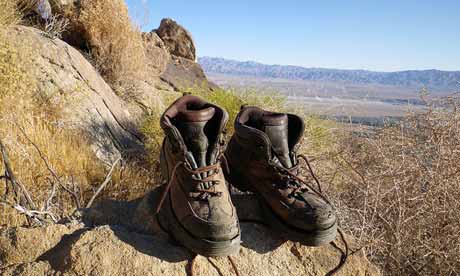
Pushing your body physically, in often extreme environments, can take its toll. Pre-trek preparation is key if you want to enjoy the journey
First decide on the appropriate shoes: will you need sturdy, waterproof hiking boots, trekking sandals, or will trainers do? And make sure they’re well worn in. Pack a comfy second pair of shoes for wearing post-trek.
Socks are also important – take well-fitting pairs suitable for the temperatures you’ll be facing, and consider packing snow gaiters, which will keep your feet dry when splashing through rivers. Always have a spare pair of socks to hand in case the ones you’re wearing get wet – damp socks cause the skin to soften and make it more prone to breaking down.
If you have a condition such as athletes’ foot, treat it before you leave and pack anti-fungal cream/powder. Also take dressings to pad areas of skin that become blistered. If blisters form they shouldn’t be punctured, but they do need cushioning.
If you’re hacking through thorny scrub or steamy jungle wear long clothes that cover your whole body. Less exposed skin also means you need to apply less repellent and/or sunscreen. Treat your clothes with permethrin for extra bug protection.
Hats and sunglasses should be worn, particularly at altitude where the sun is stronger. A good sunscreen should be used, though remember to reapply frequently as it will sweat off quickly in hot climates and during activity.
You will heat up as you walk, so wear layers and consider high-wicking fabrics that whisk moisture away from the skin. Once you’ve stopped walking, you’ll cool quickly so pack warm clothes to change into each evening.
Think about the colour of your clothes too – red, white or other visible shades, which will alert and scare off any wildlife.
Know what you’re signing up for and make sure you attain a basic level of fitness for your trek, preferably with some walking practise at home. Quadriceps-strengthening exercises will help avoid knee injuries (see right); try exercises aimed at skiers. Walking with trekking poles can reduce the stress on your knees, too.
Hiking at altitude is harder on the body. Ascend slowly, and know and look out for the symptoms of acute mountain sickness.
It’s a challenge to take in enough liquid if the environment is hot and/or humid, and when you’re at altitude. Fluid absorption is speeded up by taking hypotonic or sugary drinks or thin soups. You should drink enough to pass at least three good-volume, pale-coloured urinations every 24 hours; the amount of fluid required varies but is likely to be at least two litres. Using a water-hoser, instead of a water bottle, will allow you to drink without having to stop.
Pack iodine to purify water en route – water from mountain steams may look clean but could be contaminated. Boiling water will also purify it; although water boils at a lower temperature at altitude, boiling still kills the bugs most likely to harm you.
Small, frequent meals and snacks will keep energy levels up, and boost morale. The best foods are rich in carbohydrates, for example, pasta and breads.
Trekking through undergrowth carries a risk of picking up ticks, and most ticks potentially carry disease – some of which are nasty and untreatable. Bite avoidance is important – cover up and use repellent. Trekkers visiting the hills or forests of central or eastern Europe or central Asia should check if they need immunisation against tick-borne encephalitis.
Even in deserts there are animal hazards, in the form of scorpions and snakes. Put your boots on (after shaking them out first) before walking outside.
Trekkers do get nudged off mountain paths by pack animals, goats and sheep. Stand on the uphill side of any trail and stand still. Horned animals such as yaks will walk around you.
Read up on precautions if in bear country, and don’t sleep with food in your tent. Village dogs are encouraged to see off strangers; stoop down as if to pick up a stone if threatened. Don’t run.